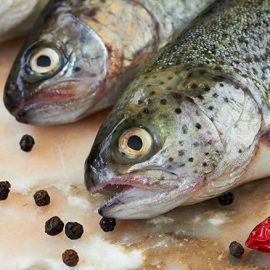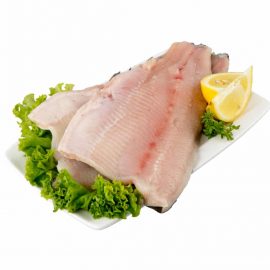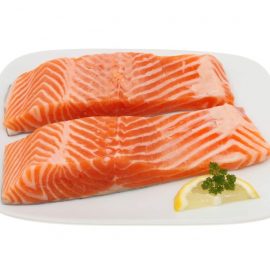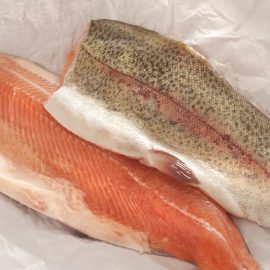
Introduction
Trout is a freshwater fish species belonging to the Salmonidae family, which also includes fish such as salmon and grayling. Native to Europe, Asia, and North America, trout are recognised for their slim bodies with bright and speckled colouring.
Trout is a species of freshwater fish found across the Northern Hemisphere. Trout can be found in rivers, streams, ponds, lakes, reservoirs, and even in standing water and estuaries, as long as the water is cold and well-oxygenated.
Description
T trout comes from the 14th-century Anglo-French word ‘tro(u)te’. It is believed to be related to a Proto-Germanic word meaning ‘to move swiftly’, evidenced in its other language forms, such as Ancient Greek ostroktonos, meaning ‘fast swimmer’.
The Old English form, trouthe, referred initially to a walking, racing, or running motion. Trout have also been referred to as ‘salmon trout’ due to cross-family features such as similarity in appearance and partially migratory behaviour.
Trout are highly prized among anglers as they are sought-after sport fish that offer an exciting and thrilling fishing experience. They have impressive swimming abilities, which makes them a challenge to catch and is what makes them popular among recreational anglers. They are also often artificially bred and raised in artificial reservoirs and lakes for use in sport fishing.
Physical Characteristics
Trout have slender bodies that typically measure between 12.7 cm and 114.3 cm (5 and 45 inches) in length and weigh between 1 ounce and 10 kg (22 lb). They possess a light-coloured underside, olive-green back, numerous horseshoe-shaped scales, and a distinct caudal fin with a truncated shape.
Male and female fish trout differ slightly in their physical characteristics, as males tend to develop bright-coloured bodies, hooked jaws, and a larger size during the mating season to attract a mate. Females, on the other hand, usually have more muted colours and less hook-like jaws.
Trout have prominent eyes with excellent vision and an olfactory lobe, which grants them a heightened sense of smell. Additionally, these fish have a relatively large mouths with numerous small, sharp teeth.
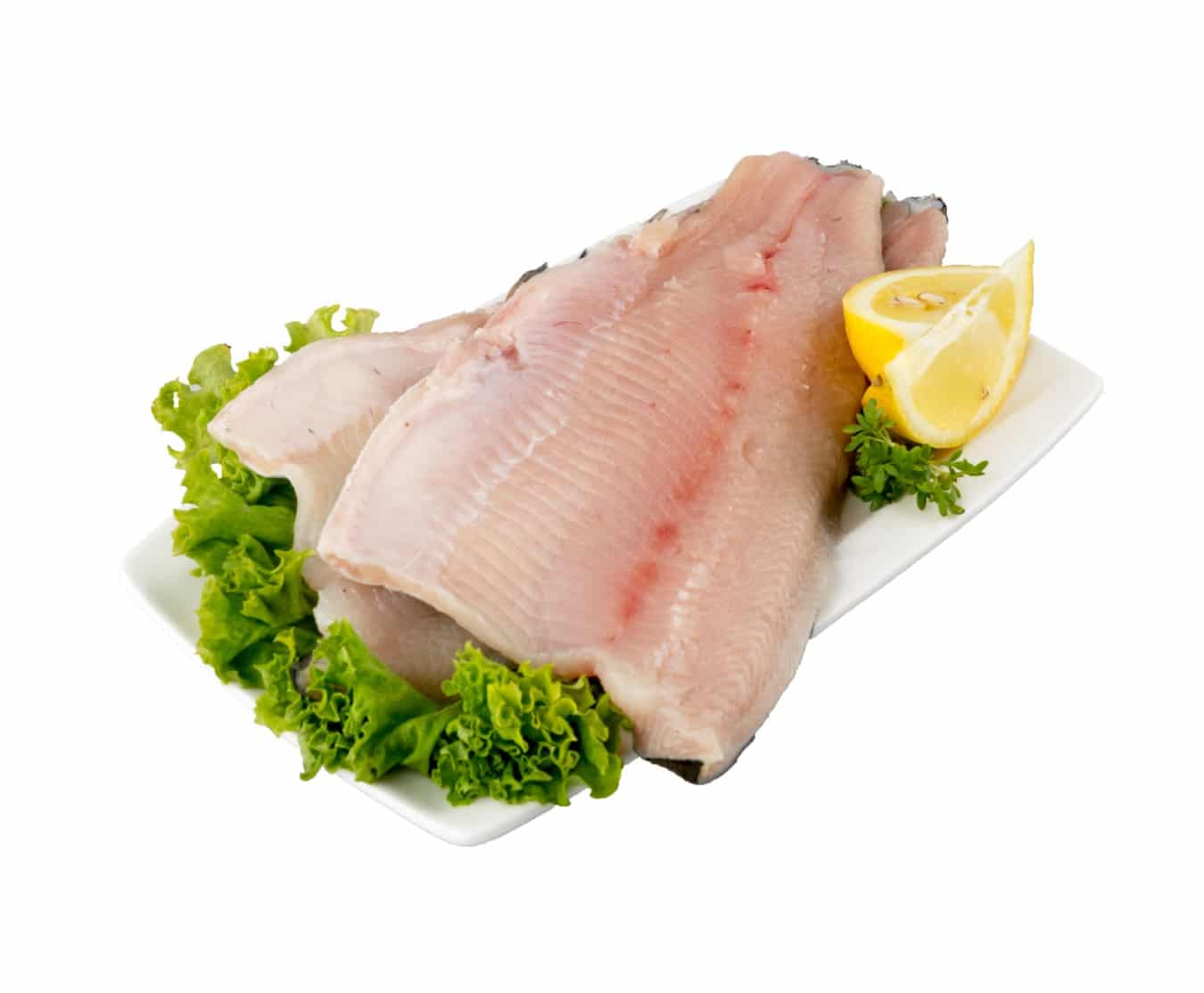
Habitat and Feeding
Trout adapt to habitats like rivers, lakes, and coastal areas, depending on the species.
They are also apex predators and integral to the aquatic food chain. They use their excellent vision and sense of smell to identify, hunt, and feed on various prey, such as aquatic insects and small fish.
As a form of defence against predators, trout also seek out areas with pools, riffles, runs, eddies, and hiding places. In some cases, they may even migrate to areas where their original habitat has been affected by human activity.
Trout are commonly found in subarctic regions, cool temperate zones, and across countries like North America, Europe, Russia, Japan, and Asia.
Trout Fishing
Anglers have many methods of catching trout, including fly-fishing, bait-fishing, and trolling. Fly-fishing and bait fishing are popular for recreational anglers while trolling is favoured by commercial fishers due to its efficiency.
Trout Fishing is heavily regulated and managed, with rules and regulations varying according to species, region, and jurisdiction.
Anglers use various tools and techniques to catch Trout in a trout farm, ranging from traditional methods such as hand-held rod and line fishing, net fishing, trolling, and spinning to more modern technologies.
Different bait and lures, such as worms, shrimp, or crayfish, may be necessary. Many governments and organisations maintain catch limits, size limitations, and closed or restricted seasons and waters. Fly fishing, ice fishing, and other forms of fishing are popular methods to catch Trout.
Population and Conservation
Despite its popularity, some trout species are threatened by the destruction and degradation of their habitats. Several conservation efforts are in place to ensure that trout survive and thrive in their natural habitats.
Additionally, anglers are encouraged to practice catch-and-release fishing, which helps to maintain healthy trout populations.
Distribution of Stocks
Trout is one of the world’s most widely distributed species of fish. Their adaptability and ability to survive in diverse environments and climatic conditions have been essential in maintaining natural food webs and healthy ecosystems.
Trout (Salmo trutta) are a highly sought-after species of freshwater fish found worldwide in rivers, streams, ponds, lakes, and even in the ocean, in temperate climates such as those found in Europe, the United States, Canada, and Australia.
Conservation Status
According to the IUCN red list, most Trout species are of Least Concern. However, some species are considered vulnerable or Endangered due to human pressures, such as deforestation, pollution and overfishing. Conservation efforts for wild Trout should focus on habitat restoration and protecting spawning grounds.
Sustainable Fishing Practices
In addition to government-level Trout management programs, various conservation strategies have been established to promote sustainable Trout fisheries. Trout conservation and research organisations work to conduct research on the species and advocate for their preservation of the wild and farmed trout.
Public education campaigns to raise awareness about this native fish, Trout and its importance, plus the adoption of fishing techniques such as catch-and-release, artificial lures and barbless hooks, have also been proven to help ensure Trout populations remain healthy.
Trout’s Diet
Trout feed on a wide range of aquatic and terrestrial invertebrates, including insects, larvae, worms, crustaceans, molluscs, baitfish, zooplankton, vegetation, and even some small mammals.
This wild fish feed on invertebrates such as crayfish, mayflies, stoneflies, caddisflies, and larvae of aquatic insects. Small fish such as minnows, sculpins, and juvenile trout may also be eaten, as well as adult crayfish, snails, and clams.
Some species of brook trout that live in fast-flowing water rely on the insects that drift by in the current, and they may also consume terrestrial insects when the insect population near the water is high. Trout may also feed on plant material, such as algae, leaves, and other vegetation.
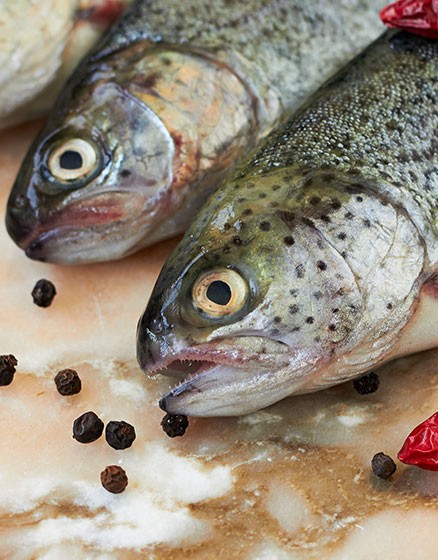
Reproduction
Trout reproduce through sexual reproduction, either by external spawning or protogyny. In spawning, the female lays a spawn of eggs that are then spermated by male Trout.
Protogyny involves the sex change of a female Trout to a male. During the reproductive season, female Trout carry mature eggs in their ovaries, and males have sperm in their testes. The eggs are laid in the gravel spawning nest to be fertilised.
Trout can have high fecundity, producing large numbers of eggs – from 2,000 to 12,000, depending on size and season. Females will spawn up to three times a year, and males can spawn multiple times throughout their lifetime.
Spawning Habitats
The juvenile fish engage in migratory behaviour, travelling long distances between breeding and feeding grounds.
Typically, Trout spawn in the freshwaters of the reaches, migrate to larger bodies of fresh water for the summer and return to smaller bodies to spawn in the Fall.
They also have varying lifespans, depending on species and environmental conditions, which heavily rely on temperature and available food sources.
Trout typically spawn during the spring months, when the water temperature increases and is conducive to egg incubation. Spawning continues throughout the summer, with fry hatching in the early stages. The fry begins to feed on insects and other invertebrates until they are mature enough to depart their nursery lake or stream.
Average Lifespan of Trout
Trout inhabiting cold water tend to live longer, with average lifespans ranging between 6 to 9 years. Species-dependent longevity must also be considered, with some sea trout and river trout varieties longer-lived than others. For instance, the cutthroat trout is a species renowned for its permanent presence in its environment.
Similarly, size-based lifespans in trout can also be identified, e.g., large trout are believed to have a higher lifespan than smaller, young trout. Male trout also tend to have shorter lifespans than females due to the extra energy spent during reproduction.
Taxonomy of Trout
Trout species vary in taxonomy depending on their geographic region, environment and physical characteristics. Rainbow Trout, Brown Trout, Lake Trout, Steelhead, Cutthroat Trout, Cherry Salmon and Bull Trout are the most commonly recognised trout species.
Trout in Culinary Cuisine
Trout are more than just sought-after sport fish. They are also a popular food fish and feature in various dishes. With firm and delicate flesh, they offer a deliciously subtle and slightly nutty flavour to many dishes, making them a popular ingredient in many different cooking styles. They are omnivorous and can feed on small insects, plants and other small prey, making them a versatile ingredient in many dishes.
Significance
Trout are a popular target for anglers thanks to its size, plentifulness, and flavour. They are also known to be stocked by wildlife agencies to keep streams healthy with nice river flow.
Their size and colour also make them an ideal species to keep in aquaria, and they make fascinating decorative additions. Trout also provides sustenance, protein, and other essential nutrients to many societies worldwide.
Trout Popularity Among Anglers
Trout are highly prized among anglers as they are sought-after sport fish that offer an exciting and thrilling fishing experience. They have impressive swimming abilities, making them a challenge to catch and popular among recreational anglers. They are also often artificially bred and raised in man-made reservoirs and lakes for use in sport fishing.
Nutritional Values
Trout is a nutrient-dense food rich in healthy proteins and essential fatty acids. It is high in omega-3 fatty acids, which are beneficial for cardiovascular, joint and cellular health. It also contains a good mix of B vitamins and other essential minerals, including phosphorus, selenium and zinc.
Furthermore, trout is an excellent source of vitamin D, which helps the body absorb calcium for strong bones. Additionally, trout is low in fat, calories, sodium, and cholesterol.
Health Benefits
Eating Trout can provide a range of beneficial health effects, such as improved heart health, cognitive benefits, increased immunity, and a lower risk of diabetes. Studies also suggest that eating Trout may reduce the risk of certain types of cancer and promote healthier skin, hair, nails, and joints.
Trout may also contain trace amounts of mercury. However, consumption amounts should remain moderate to ensure minimal health risks.
Trout is a popular choice for chefs as it is relatively easy to prepare and is a good source of essential nutrients. It is also a low-calorie, low-fat fish, containing about 120 calories per 3-ounce portion.
Trout is a delicious and nutritious addition to any meal, sure to impress your taste buds no matter how you prepare it.
Taste and Texture
Trout have distinct visual appeal; their distinctive marbling and vibrant colours offer a unique sight compared to other fish. They also have a mild flavour that pairs well with light ingredients such as lemon, olive oil, and herbs, as well as more buttery ingredients. Trout also has a higher fat content than other fish, resulting in a richer and fuller flavour.
Trout is prized for its mild, nutty taste and delicate, flaky texture, more similar to salmon than other types of fish. Trout is known for its savoury flavour and is often used in traditional fish recipes, such as chowder, pie, and fish tacos.
Different species of trout, such as brown and rainbow trout, have different tastes and fat content. The high-fat range of these species carries a unique, sweet flavour and adds a certain richness to the fish.
Variety of Preparation Methods
Trout is a highly versatile fish, and its mild flavour allows various recipes to enhance its taste. There are many ways to prepare it, including baking, grilling, frying, and smoking, and it is even used as the main ingredient in sushi dishes.
Cooking Methods
When cooking Trout, avoiding overcooking for a dry resulting fish is essential. Popular cooking methods Trout include grilling, baking, sautéing, pan-frying, poaching, broiling, and smoking.
Grilling is a popular method for Trout that produces excellent results. It should ideally be marinated for 30 minutes in a mixture of lemon juice, herbs, and spices and basted in oil or butter before being cooked over medium-high heat. Additionally, a light dusting of flour and lemon juice can be added to bring out the natural flavour of the Trout.
Trout should be lightly coated with butter, oregano, garlic, salt, and pepper when baking.
Poaching Trout involves simmering it in a mixture of white wine and herbs, whereas for pan-frying, Trout should be seasoned and pan-seared before being cooked in a warm skillet.
To deep-fry Trout, it should be lightly coated in flour or batter and fried in oil until it is crisp and golden. Smoking is another popular cooking method and requires specialised equipment.

Side Dishes to Accompany Trout
Trout can be served with a wide variety of sides, including roasted vegetables, salads, grains like quinoa or brown rice, grilled bell peppers, mushrooms, tomatoes, garlic and onions, potatoes, risotto, noodles, mashed potatoes, corn on the cob, sautéed greens, steamed vegetables and a light salad.
Suitable Sauces & Spices
Sauces and condiments such as hollandaise sauce, white wine sauce, dill yoghurt, lemony butter or pesto, as well as other flavours such as capers, almonds, lemon, fennel, garlic, and fresh herbs such as dill, basil and sage can enhance the flavours of the Trout dish.
Popular Recipes
Popular recipes for Trout include baked Trout with garlic, rosemary, butter, and lemon; pan-fried Trout in cornmeal with salsa verde; grilled Trout with honey and ginger; baked Trout with capers and dill; poached Trout in white wine; and smoked Trout carpaccio with horseradish, dill, and lemon.
Other popular recipes include smoked Trout dip, trout and asparagus foil packs, and trout with orange sauce.
Conclusion
Trout remains one of the world’s most celebrated fish species, offering anglers and commercial fishermen an unforgettable fishing experience. Trout is a delicious and nutritious game fish that is widely consumed and highly valued in the culinary world. Its mild flavour and delicate texture make it an ideal choice for various recipes, while its health benefits make it nutritious. Whether grilled, baked, pan-fried, poached, smoked or canned, trout is sure to add a unique and delicious flavour to any dish.
